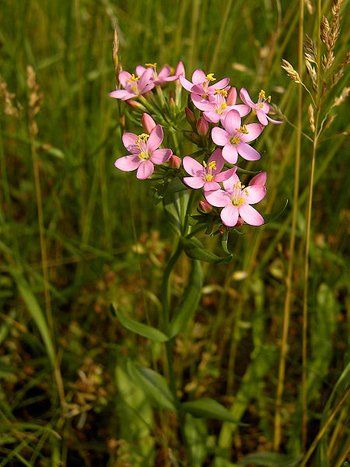Contents:
Common Names | Parts Usually Used | Plant(s) & Culture | Where Found | Medicinal Properties | Biochemical Information
Legends, Myths and Stories | Uses | Formulas or Dosages | Warning | Bibliography
Scientific Names

- Erythraea centaurium L.
- Centaurii majoris
- Sabbatia angularis, Pers.
- Gentianaceae
- Gentian family
Common Names
- American centaury
- Bitter herb
- Bluebottle
- Bluet
- Century
- Centory
- Christ’s ladder
- Common centaury
- European centaury
- Feverwort
- Forking centaury
- Greater centaury
- Red centaury
Parts Usually Used
Aerial portions
Back to Top
Description of Plant(s) and
Culture
A small plant of the gentian family, with flat-clusters of red or rose flowers. The stem is four-cornered and grows to a height of 4-20 inches (10-50 cm). The leaves are decussate. The red, star-shaped flowers, which open only when the sun shines, are arranged in umbellike panicles.
Flower in July and seed within a month after.
The small or lesser centaury has yellow flowers. Used the same as greater centaury.
There is a centaury that has white flowers. Not found commonly in the wild.
Back to Top
Where Found
Grows in Europe, Asia, North Africa, and North America. Found in damp meadows, pastures, and in thinly wooded areas.
Back to Top
Medicinal Properties
Tonic, stomachic, aromatic, cholagogue, diaphoretic, digestive, febrifuge, emetic, stimulant
Back to Top
Biochemical Information
Bitter principles, including gentiopicrine and erythrocentaurin, valeric acid, wax, etc.
Back to Top
Legends, Myths and Stories
Remember the old saying “Medicine has to taste bitter; otherwise, it won’t do any good” ? That applies double to centaury.
Named after the Centaur, Chiron, who was said to have discovered medicinal properties of the plant.
Culpeper says of Centaury, “Tis very wholesome; but not very toothsome.”
Back to Top
Uses
This is an herb that may be used for nearly any problem. A tonic for those who are unable to exercise in the open air. It is used for gas, colic, bloating, heartburn, dyspepsia, stimulate appetite, and constipation, and aids the proper assimilation and digestion of food. If taken in too concentrated an infusion, it will produce vomiting. Extract prepared with vodka is given for high blood pressure, liver and gall bladder problems. Lotions containing centaury have been used on the skin to remove different kinds of blemishes. It is used as a treatment for muscular rheumatism, gout, convulsions, tuberculosis, cramps, snakebites, helps vision. It kills worms as do most bitters.
Externally, the juice applied to the eyes will clear the vision, and applied to wounds, ulcers, old sores, bruises, will help promote healing. The decoction applied to the skin regularly will clear the skin of freckles and spots. In ancient times it was a primary cure for intermittent fevers and malaria, as well as a remedy for snake poison and other animal bites. A decoction externally applied also will destroy lice and other parasites in the hair.
Back to Top
Formulas or Dosages
Use 2 tsp. of the herb to 1 cup of boiling water; let steep for 20-30 minutes, cool, and take a cupful every day, one swallow at a time.
Tincture: 1 tsp. taken before meals.
Back to Top
Warning
Do not collect this medicinal plant yourself under any circumstances, as European centaury, like all other members of the gentian family, is on the list of protected plants!
Back to Top
Bibliography
![]() Back to Eden
Back to Eden, by Jethro Kloss; Back to Eden Publishing Co., Loma Linda, CA 92354, Original copyright 1939, revised edition 1994
![]() The Nature Doctor: A Manual of Traditional and Complementary Medicine
The Nature Doctor: A Manual of Traditional and Complementary Medicine, by Dr. H.C.A. Vogel; Keats Publishing, Inc., 27 Pine Street (Box 876) New Canaan, CT. 06840-0876. Copyright Verlag A. Vogel, Teufen (AR) Switzerland 1952, 1991
![]() The Complete Medicinal Herbal
The Complete Medicinal Herbal, by Penelope Ody, Dorling Kindersley, Inc, 232 Madison Avenue, New York, NY 10016, First American Edition, copyright 1993
Herbal Gardening, compiled by The Robison York State Herb Garden, Cornell Plantations, Matthaei Botanical Gardens of the University of Michigan, University of California Botanical Garden, Berkeley., Pantheon Books, Knopf Publishing Group, New York, 1994, first edition
 The Magic of Herbs
The Magic of Herbs, by David Conway, published by Jonathan Cape, Thirty Bedford Square, London, England. (Out of print)
![]() Indian Herbalogy of North America
Indian Herbalogy of North America, by Alma R. Hutchens, Shambala Publications, Inc., Horticultural Hall, 300 Massachusetts Avenue, Boston, Massachusetts 02115, 1973
![]() The Complete Medicinal Herbal
The Complete Medicinal Herbal, by Penelope Ody, Dorling Kindersley, Inc, 232 Madison Avenue, New York, NY 10016, First American Edition, copyright 1993
![]() Planetary Herbology
Planetary Herbology, by Michael Tierra, C.A., N.D., O.M.D., Lotus Press, PO Box 325, Twin Lakes. WI 53181., Copyright 1988, published 1992
![]() American Folk Medicine
American Folk Medicine/i>, by Clarence Meyer, Meyerbooks, publisher, PO Box 427, Glenwood, Illinois 60425, 1973
![]() Webster’s New World Dictionary
Webster’s New World Dictionary, Third College Edition, Victoria Neufeldt, Editor in Chief, New World Dictionaries: A Division of Simon & Schuster, Inc., 15 Columbus Circle, New York, NY 10023
 The Rodale Herb Book: How to Use, Grow, and Buy Nature’s Miracle Plants (An Organic gardening and farming book)
The Rodale Herb Book: How to Use, Grow, and Buy Nature’s Miracle Plants (An Organic gardening and farming book), edited by William H. Hylton, Rodale Press, Inc. Emmaus, PA, 18049., 1974
![]() The Yoga of Herbs: An Ayurvedic Guide to Herbal Medicine
The Yoga of Herbs: An Ayurvedic Guide to Herbal Medicine, by Dr. David Frawley & Dr. Vasant Lad, Lotus Press, Twin Lakes, Wisconsin, Second edition, 1988.
 The Healing Plants
The Healing Plants, by Mannfried Pahlow, Barron’s Educational Series, Inc. 250 Wireless Blvd., Hauppauge, NY 11788, 1992
